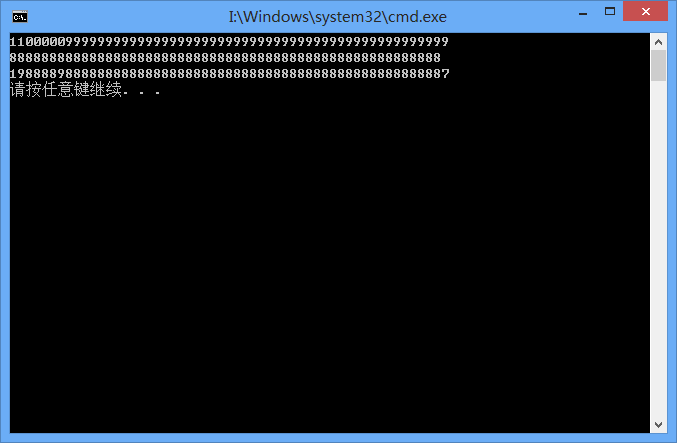兩個大數相加,使用字串模擬相加過程
阿新 • • 發佈:2019-01-04
大數相加不能直接使用基本的int型別,因為int可以表示的整數有限,不能滿足大數的要求。可以使用字串來表示大數,模擬大數相加的過程。
思路:1.反轉兩個字串,便於從低位到高位相加和最高位的進位導致和的位數增加;
2.對齊兩個字串,即短字串的高位用‘0’補齊,便於後面的相加;
3.把兩個正整數相加,一位一位的加並加上進位。
具體程式碼如下:
執行結果:/** * 兩個大數相加,且這兩個大數是正整數 * 暫時不考慮負數,不考慮輸入不合法的情況 * 要保證輸入是正確的才能保證程式正常執行 */ #include <stdio.h> #include <string.h> #define MAXSIZE 1000 int main() { char number1[MAXSIZE+1]; char number2[MAXSIZE+1]; char sum[MAXSIZE+2]; char temp1[MAXSIZE+1]; char temp2[MAXSIZE+1]; int len1 = 0; int len2 = 0; int i = 0; int j = 0; int maxLen = 0; int nSum = 0; int nCarryBit = 0; int nOverFlow = 0; gets(number1); gets(number2); //1.反轉字串,便於從低位到高位相加和最高位的進位導致和的位數增加 len1 = strlen(number1); len2 = strlen(number2); j = 0; for(i = len1-1; i >= 0; --i) { temp1[j++] = number1[i]; } temp1[j] = '\0'; j = 0; for(i = len2-1; i >= 0; --i) { temp2[j++] = number2[i]; } //2.把兩個字串補齊,即短字串的高位用‘0’補齊 maxLen = (len1 > len2)?len1:len2; if(len1 < len2) { for(i = len1; i < len2; ++i) temp1[i] = '0'; temp1[len2] = '\0'; } else if(len1 > len2) { for(i = len2; i < len1; ++i) temp2[i] = '0'; temp2[len1] = '\0'; } //3.把兩個正整數相加,一位一位的加並加上進位 for(i = 0; i < maxLen; i++) { nSum = temp1[i] - '0' + temp2[i] - '0' + nCarryBit; if(nSum > 9) { if(i == (maxLen-1)) { nOverFlow = 1; } nCarryBit = 1; sum[i] = nSum - 10 + '0'; } else { nCarryBit = 0; sum[i] = nSum + '0'; } } //如果溢位的話表示位增加了 if(nOverFlow == 1) { sum[maxLen++] = nCarryBit + '0'; } sum[maxLen] = '\0'; //從後向前輸出,即是相加後的值 for(i = maxLen-1; i >=0; --i) putchar(sum[i]); printf("\n"); return 0; }

